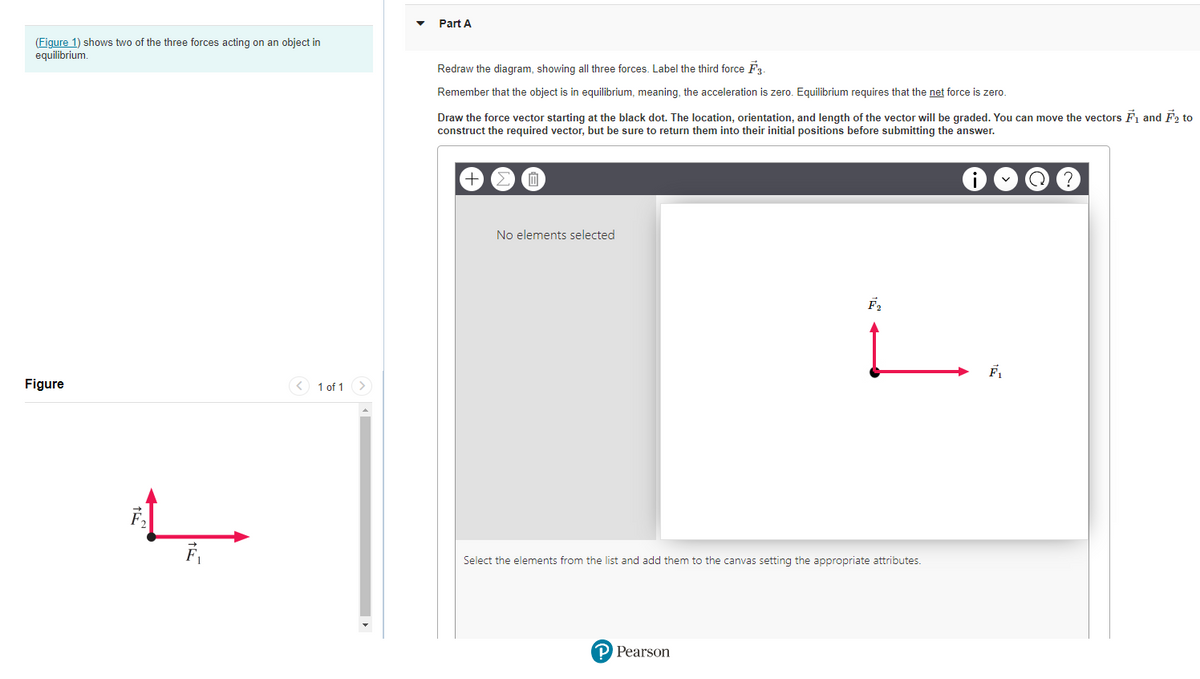(Figure 1) shows two of the three forces acting on an object in equilibrium. Figure F₁ < 1 of 1 > Part A Redraw the diagram, showing all three forces. Label the third force F3 Remember that the object is in equilibrium, meaning, the acceleration is zero. Equilibrium requires that the net force is zero. Draw the force vector starting at the black dot. The location, orientation, and length of the vector will be graded. You can move the vectors F₁ and F₂ to construct the required vector, but be sure to return them into their initial positions before submitting the answer. No elements selected Select the elements from the list and add them to the canvas setting the appropriate attributes. P Pearson F₁
(Figure 1) shows two of the three forces acting on an object in equilibrium. Figure F₁ < 1 of 1 > Part A Redraw the diagram, showing all three forces. Label the third force F3 Remember that the object is in equilibrium, meaning, the acceleration is zero. Equilibrium requires that the net force is zero. Draw the force vector starting at the black dot. The location, orientation, and length of the vector will be graded. You can move the vectors F₁ and F₂ to construct the required vector, but be sure to return them into their initial positions before submitting the answer. No elements selected Select the elements from the list and add them to the canvas setting the appropriate attributes. P Pearson F₁
Elements Of Electromagnetics
7th Edition
ISBN:9780190698614
Author:Sadiku, Matthew N. O.
Publisher:Sadiku, Matthew N. O.
ChapterMA: Math Assessment
Section: Chapter Questions
Problem 1.1MA
Related questions
Question

Transcribed Image Text:(Figure 1) shows two of the three forces acting on an object in
equilibrium.
Figure
L
< 1 of 1
Part A
Redraw the diagram, showing all three forces. Label the third force F3.
Remember that the object is in equilibrium, meaning, the acceleration is zero. Equilibrium requires that the net force is zero.
Draw the force vector starting at the black dot. The location, orientation, and length of the vector will be graded. You can move the vectors F₁ and F2 to
construct the required vector, but be sure to return them into their initial positions before submitting the answer.
11
No elements selected
F₂
Select the elements from the list and add them to the canvas setting the appropriate attributes.
P Pearson
F₁
Q
Expert Solution
This question has been solved!
Explore an expertly crafted, step-by-step solution for a thorough understanding of key concepts.
This is a popular solution!
Trending now
This is a popular solution!
Step by step
Solved in 4 steps with 4 images

Knowledge Booster
Learn more about
Need a deep-dive on the concept behind this application? Look no further. Learn more about this topic, mechanical-engineering and related others by exploring similar questions and additional content below.Recommended textbooks for you

Elements Of Electromagnetics
Mechanical Engineering
ISBN:
9780190698614
Author:
Sadiku, Matthew N. O.
Publisher:
Oxford University Press

Mechanics of Materials (10th Edition)
Mechanical Engineering
ISBN:
9780134319650
Author:
Russell C. Hibbeler
Publisher:
PEARSON

Thermodynamics: An Engineering Approach
Mechanical Engineering
ISBN:
9781259822674
Author:
Yunus A. Cengel Dr., Michael A. Boles
Publisher:
McGraw-Hill Education

Elements Of Electromagnetics
Mechanical Engineering
ISBN:
9780190698614
Author:
Sadiku, Matthew N. O.
Publisher:
Oxford University Press

Mechanics of Materials (10th Edition)
Mechanical Engineering
ISBN:
9780134319650
Author:
Russell C. Hibbeler
Publisher:
PEARSON

Thermodynamics: An Engineering Approach
Mechanical Engineering
ISBN:
9781259822674
Author:
Yunus A. Cengel Dr., Michael A. Boles
Publisher:
McGraw-Hill Education

Control Systems Engineering
Mechanical Engineering
ISBN:
9781118170519
Author:
Norman S. Nise
Publisher:
WILEY

Mechanics of Materials (MindTap Course List)
Mechanical Engineering
ISBN:
9781337093347
Author:
Barry J. Goodno, James M. Gere
Publisher:
Cengage Learning

Engineering Mechanics: Statics
Mechanical Engineering
ISBN:
9781118807330
Author:
James L. Meriam, L. G. Kraige, J. N. Bolton
Publisher:
WILEY